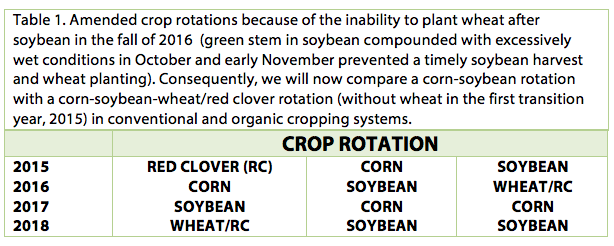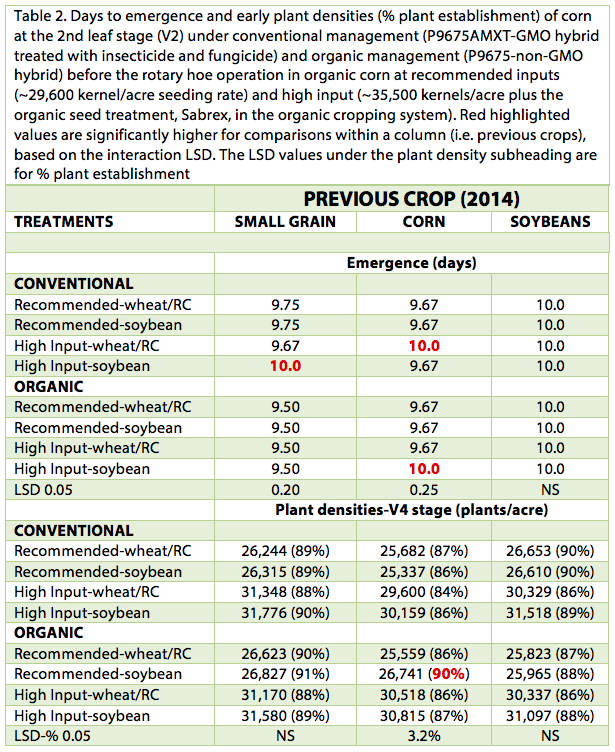Bill Cox1, Eric Sandsted1, Phil Atkins2, and RJ Richtmyer2
1Soil and Crop Sciences Section; 2New York Seed Improvement Project, Plant Breeding and Genetics Section – School of Integrative Plant Science, Cornell University

We initiated a 4-year study at the Aurora Research Farm in 2015 to compare different sequences of the corn, soybean, and wheat/red clover rotation in conventional and organic cropping systems under recommended and high input management during the 3-year transition period (2015-2017) from conventional to an organic cropping system. We provided a detailed discussion of the various treatments and objectives of the study in a previous corn article (https://blogs.cornell.edu/whatscroppingup/2015/07/23/emergence-early-v4-stage-and-final-plant-populations-v10-psnt-values-v4-and-weed-densities-v12-in-corn-under-conventional-and-organic-cropping-systems/). Unfortunately, we were unable to plant wheat after soybean in the fall of 2016 because green stem in soybean compounded with very wet conditions in October and early November delayed soybean harvest until November 9, too late for wheat planting. Consequently, we altered the rotations to accommodate the situation (Table 1). This article will focus on corn emergence (days) and plant densities (% plant establishment) at the V2 stage following wheat/red clover (intended previous crop before corn in the rotation) and after soybean (unintended previous crop but had to plant corn instead of wheat) before the rotary hoeing operation in the organic cropping system.
The red clover green manure crop (~3.25 dry matter tons/acre) was mowed down on May 16. The fields were plowed on May 17, then cultimulched on the morning of May 18, the day of planting. We planted a treated (insecticide/fungicide seed treatment) GMO corn hybrid, P96AMXT, in the conventional system; and its isoline, the untreated non-GMO, P9675, in the organic cropping system at two seeding rates, ~29,600 kernels/acre (recommended input treatment) and 35,500 kernels/acre (high input). The high input organic treatment also received the organic seed treatment (in-hopper), Sabrex.
Weather conditions were cool and wet for the first 10 days after planting (59o F average temperature and 2.0 inches of precipitation). Nevertheless, corn emergence required only 9 to 10 days (Table 2), or 90 to 95 growing degree days, instead of the typical 110-120 growing degree days. Presumably, the wet soil conditions at the time of planting shortened the emergence time below the typical thermal unit requirement. Surprisingly, the non-GMO P9675, with or without the organic seed treatment (only in high input), compared with its isoline, the GMO P9675AMXT with seed treatment (insecticide/fungicide), emerged at the same time. In 2014, another year with wet and cool conditions, the GMO hybrid emerged about 0.50 days more rapidly than the non-GMO hybrid (https://blogs.cornell.edu/whatscroppingup/2015/06/16/days-to-emergence-and-early-corn-and-soybean-plant-populations-under-conventional-and-organic-cropping-systems/). Days to emergence did not differ between the recommended and high input treatments in the organic cropping system, indicating that Sabrex, the organic seed treatment, did not hasten corn emergence in 2017, similar to results in 2015 and 2016.
We estimated corn plant densities in all treatments at the V2 stage (June 2), just prior to the rotary hoeing operation. We will take measurements before the subsequent close cultivation to determine to what extent the rotary hoeing operation reduced corn densities in the organic cropping system. Visual observation, however, indicated very little damage. Corn emergence was relatively high in 2016 (Table 2) given the wet and cool conditions. Conventional and organic corn generally had 85% to 90% plant establishment with no significance difference between cropping systems. In previous years, organic compared with conventional corn had significantly fewer plants/acre. Measurements in the two previous years, however, were taken shortly after the rotary hoeing operation, which probably reduced early plant densities in organic corn. Percent early plant establishment did not differ between the recommended and high input treatments in the organic cropping system, indicating that Sabrex, the organic seed treatment, did not improve stand establishment in 2017, similar to results in 2015 and 2016. Likewise, the previous crop (wheat/red clover or soybean), did not influence plant densities at the V2 stage in organic and conventional cropping systems.
Based on the crop emergence and plant density data at the V2 stage, organic and conventional corn have the same yield potential. It remains to be seen if plant densities are similar between cropping systems after the numerous cultivations, especially the rotary hoe and close cultivation operations, in organic corn.



